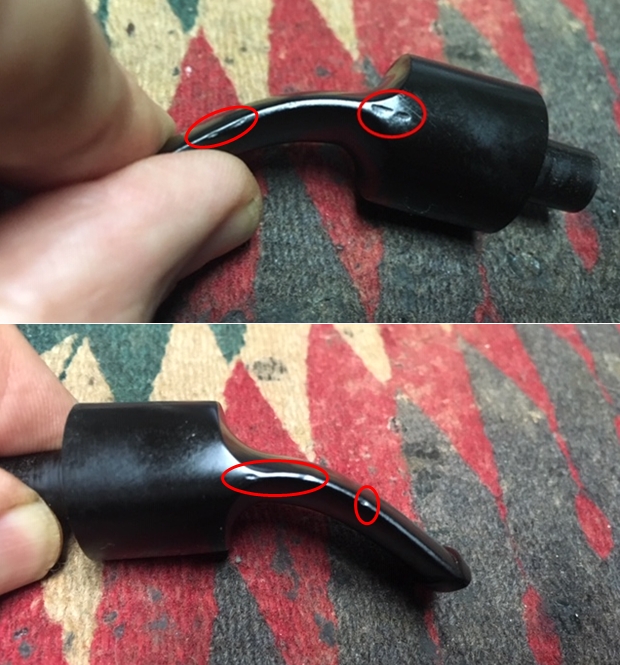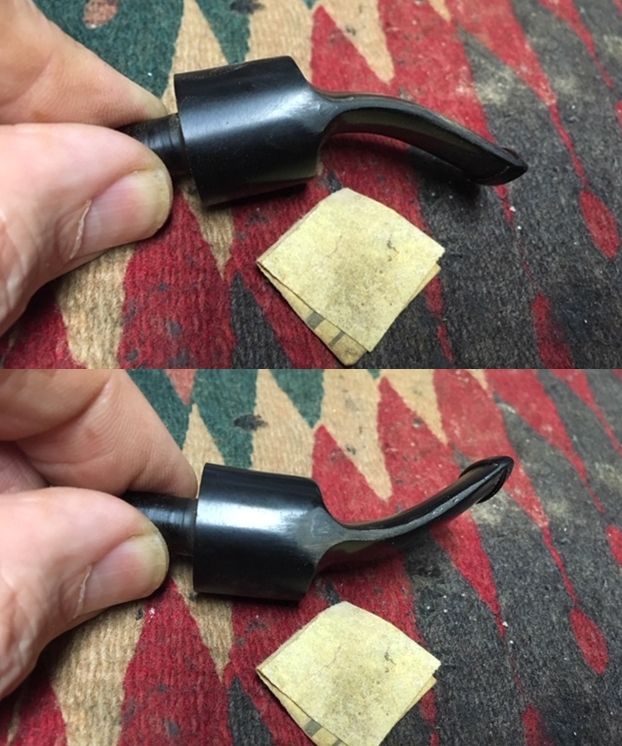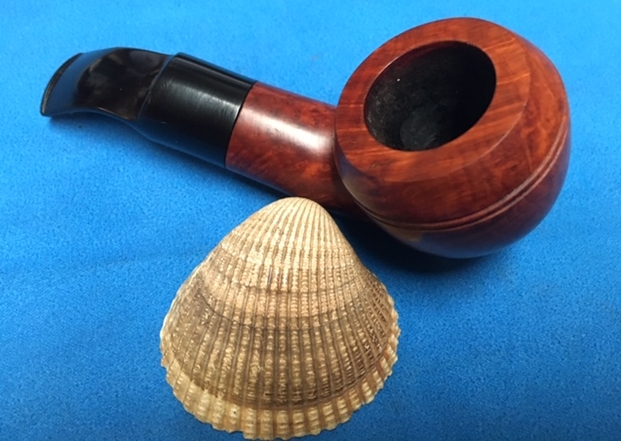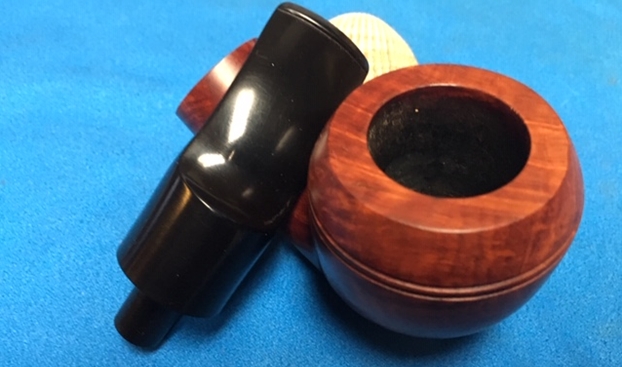Blog by Steve Laug
Rather than repeat myself and give the blog readers grief with the repetition please refer to the previous blog posts on the Bertrams to learn about how my brother and I picked up this pipe collection. Just know that we have a collection of Bertrams and a smattering of other brands that when they were unwrapped filled three boxes. The photo below is included to show the size of the collection we had purchased. To be honest it was a bit overwhelming to see all of the collection in boxes. We were looking at a lot of work to bring these back to life. I cannot tell you how glad I am that Jeff is working through the clean up on this lot as they are really quite dirty and there are so many! It would be a more daunting task than it already is if I had to clean and restore all of them. I am leaving it to him to choose which pipes to work on. He has chosen some interesting shaped ones to restore. Here is how we are working out the transfer from him to me. As he finishes a batch of them he boxes them up and sends them to me. I have received two boxes so far. From the first box he sent, I chose a beautifully shaped and grained Rhodesian that is stamped National over Washington D.C. to be the next pipe that I would work on. This pipe was another very dirty one! The smooth finish was grimy and dusty but some interesting grain shone through showing me that this was a beautiful pipe. There were a few rough fills and nicks on the right and left backside of the bowl. It was a large thick shank bent Rhodesian shaped pipe with a saddle stem. There was a thick cake in the bowl and some lava overflowing on to the rim top. The condition of the edges appeared to be pretty good but reaming would give an definitive clue on that. There was one small flaw on the smooth rim top on the rear right side that would need attention. The stem was dirty and showed some light oxidation but there were not any deep tooth marks. There were some flaws on the sides of the saddle stem that needed to be addressed. The photos below tell the story and give a glimpse of the pipe.
I cannot tell you how glad I am that Jeff is working through the clean up on this lot as they are really quite dirty and there are so many! It would be a more daunting task than it already is if I had to clean and restore all of them. I am leaving it to him to choose which pipes to work on. He has chosen some interesting shaped ones to restore. Here is how we are working out the transfer from him to me. As he finishes a batch of them he boxes them up and sends them to me. I have received two boxes so far. From the first box he sent, I chose a beautifully shaped and grained Rhodesian that is stamped National over Washington D.C. to be the next pipe that I would work on. This pipe was another very dirty one! The smooth finish was grimy and dusty but some interesting grain shone through showing me that this was a beautiful pipe. There were a few rough fills and nicks on the right and left backside of the bowl. It was a large thick shank bent Rhodesian shaped pipe with a saddle stem. There was a thick cake in the bowl and some lava overflowing on to the rim top. The condition of the edges appeared to be pretty good but reaming would give an definitive clue on that. There was one small flaw on the smooth rim top on the rear right side that would need attention. The stem was dirty and showed some light oxidation but there were not any deep tooth marks. There were some flaws on the sides of the saddle stem that needed to be addressed. The photos below tell the story and give a glimpse of the pipe. 
 Jeff took close-up photos of the bowl and rim to capture the condition of the pipe when it arrived. The rim top had a thick coat of lava and the bowl had a thick cake.
Jeff took close-up photos of the bowl and rim to capture the condition of the pipe when it arrived. The rim top had a thick coat of lava and the bowl had a thick cake. Jeff took pictures of the bowl sides and the heel to show the marvelous grain on the bowl. It really is quite stunning and very dirty!
Jeff took pictures of the bowl sides and the heel to show the marvelous grain on the bowl. It really is quite stunning and very dirty! The next three photos show the stamping on the sides of the bowl. The left side is stamped with the shape number 35 followed by National over Washington, D.C. The right side is stamped Imported Briar. The second photo also shows a deep flaw in the surface of the briar. Jeff did not take photos of the stem to show its condition. By and large it was in good condition with some manufacturing flaws on both sides of the stem where the saddle met the blade of the stem.
The next three photos show the stamping on the sides of the bowl. The left side is stamped with the shape number 35 followed by National over Washington, D.C. The right side is stamped Imported Briar. The second photo also shows a deep flaw in the surface of the briar. Jeff did not take photos of the stem to show its condition. By and large it was in good condition with some manufacturing flaws on both sides of the stem where the saddle met the blade of the stem.
 Before I started my restoration work I wanted to refresh my memory about the brand. I remembered from previous National Pipes that I had worked on that there was a tie to the Bertram Pipe Company in Washington, D.C. I also knew that it was a very different company than the National Briar Pipe Company of Jersey City, New Jersey but that is where all the trails let in terms of Pipedia and Pipephil’s site. I turned back to a previous blog that I had written on the brand when I restored a pipe with the same stampings to review the history and connection of the brand to Bertram. https://rebornpipes.com/tag/national-washington-d-c-pipes/. I knew that the fact that there were several of these included with the large lot of Bertram pipes that Jeff and I purchased was not accidental. Here is the link to that previous blog. I quote in part:
Before I started my restoration work I wanted to refresh my memory about the brand. I remembered from previous National Pipes that I had worked on that there was a tie to the Bertram Pipe Company in Washington, D.C. I also knew that it was a very different company than the National Briar Pipe Company of Jersey City, New Jersey but that is where all the trails let in terms of Pipedia and Pipephil’s site. I turned back to a previous blog that I had written on the brand when I restored a pipe with the same stampings to review the history and connection of the brand to Bertram. https://rebornpipes.com/tag/national-washington-d-c-pipes/. I knew that the fact that there were several of these included with the large lot of Bertram pipes that Jeff and I purchased was not accidental. Here is the link to that previous blog. I quote in part:
I had a gut feeling that the pipe had some connection to Bertram Pipe Company of Washington DC but only the vaguest memory of that connection. I could not remember where I picked that up but just had the memory. I did some searching on the Internet and found a National Briar Pipe Company of Jersey City, New Jersey with no clear ties to Washington DC on the Pipedia site. This was the company that purchased the Doodler after Tracy Mincer died. I could see that the Jersey City pipes were stamped differently and all had line names stamped on them. On the Pipephil site I found an English version that had very different stamping on the left side of the shank as well as Made in England on the right side of the shank.
Thus I was reminded of the non-connection to the New Jersey Pipe Company. The blog went on to record some information that tied the National Washington, D.C. company to Bertram more definitively. I quote
I…posted a question on Smokers Forum (SF) and Pipe Smokers Unlimited regarding the brand. I received several responses that gave me information. One of them on SF came from Ed Klang and provided me with some confirmation regarding my memory of the connection with Bertram. I quote him in full, “In the history of the Bertram company, after the fire at the Washington, D.C. facility and the decision was made to discontinue Bertram production a group of employees and a few investors wanted to buy the rights to the Bertram name, which was turned down and it was then proposed that they would rebrand the pipes as National, no mention was made whether anything ever came of that proposal. Supposedly this group did produce pipes for a while but the effort was finally abandoned and I have never been able to reliably confirm this. Just bits and pieces here and there.” Thanks Ed. This is the random memory that I was trying to dig up.
I also received a reply on SF from Radiobob that read as follows: “National Pipe and Tobacco was located on the 1700 block of Pennsylvania Avenue in Washington, D.C., just about a block from where I worked. I still have two Canadians that I bought there, as well as a Comoy’s Patina Apple. In my recollection, it closed down–much to my regret–in the mid to late 1980s.”
Those responses gave me the kind of details that I always find helpful in my restoration work. I will continue to do some digging on the company and see what I can find but that bit confirmed the visual tie to the Bertram Company of DC. Thank you for your help Ed and Bob.
Once more I had the confirmation I needed to link the two brands – Bertrams and National! On with the cleanup and restoration on this Rhodesian.
When I received the pipe Jeff had already reamed the bowl with a PipNet pipe reamer and followed up with a Savinelli Fitsall pipe knife to remove the cake. He had scrubbed out the mortise and the airway in the shank and the stem with alcohol, cotton swabs and pipe cleaners. He had scrubbed the exterior of the bowl, rim, shank and stem with a tooth brush and Murphy’s Oil Soap to remove the oils and tars on the rim and the grime on the finish of the bowl. He had rinsed it under running water. He dried it off with a soft cloth. He was able to remove lava build up on the rim top and you could see the great condition of the bowl top and edges of the rim. There was still some darkening to the rim top toward the back of the bowl. He soaked the stem in Before & After Deoxidizer to remove the oxidation. I took photos of the pipe before I started my work on it.
 I took a close up photo of the rim top to show the condition of the bowl and rim after Jeff had cleaned up the grime and lava and in doing so revealed the flaw on the right side of the rim. I have circled it in red. Both the inner edge and the outer edge of the rim look good. The stem photos show that the oxidation is gone. The surface of the vulcanite looked very good. There were some casting marks on both sides of the stem where the blade flowed from the saddle.
I took a close up photo of the rim top to show the condition of the bowl and rim after Jeff had cleaned up the grime and lava and in doing so revealed the flaw on the right side of the rim. I have circled it in red. Both the inner edge and the outer edge of the rim look good. The stem photos show that the oxidation is gone. The surface of the vulcanite looked very good. There were some casting marks on both sides of the stem where the blade flowed from the saddle. I also took a photo of the stamping on the left and right side of the shank showing how the stamping was laid out.
I also took a photo of the stamping on the left and right side of the shank showing how the stamping was laid out.  I repaired the flaws on the sides and top of the bowl with clear super glue. I used a small drop of the clear glue to fill in the spots. You can see them in the photos below. There were two on the right side, one on the left near the shank/bowl junction and one on the rim top on the right side.
I repaired the flaws on the sides and top of the bowl with clear super glue. I used a small drop of the clear glue to fill in the spots. You can see them in the photos below. There were two on the right side, one on the left near the shank/bowl junction and one on the rim top on the right side.
 Once the repairs cured I blended them into the surface of the surrounding briar with a folded piece of 220 grit sandpaper. The photos below show the sanded repairs.
Once the repairs cured I blended them into the surface of the surrounding briar with a folded piece of 220 grit sandpaper. The photos below show the sanded repairs.
 I polished the bowl and rim top with micromesh sanding pads – wet sanding it with 1500-12000 grit pads. I wiped the bowl down with a damp cloth after each pad to remove the sanding debris. After the final sanding pad I hand buffed it with a cotton cloth to raise a shine.
I polished the bowl and rim top with micromesh sanding pads – wet sanding it with 1500-12000 grit pads. I wiped the bowl down with a damp cloth after each pad to remove the sanding debris. After the final sanding pad I hand buffed it with a cotton cloth to raise a shine.




 I worked some Before & After Restoration Balm into finish of the briar with my fingertips to clean, enliven and protect it. I let the balm sit for a little while and then buffed with a cotton cloth to raise the shine. The Restoration Balm really makes the grain stands out beautifully.
I worked some Before & After Restoration Balm into finish of the briar with my fingertips to clean, enliven and protect it. I let the balm sit for a little while and then buffed with a cotton cloth to raise the shine. The Restoration Balm really makes the grain stands out beautifully.

 I set the bowl aside and turned my attention to the stem. The first two photos show the damage to the stem sides – the casting marks on both sides of the stem. I have circled them in red to highlight the damaged areas that needed to be repaired. I filled in the damaged areas with clear super glue and set the stem aside until the repairs cured.
I set the bowl aside and turned my attention to the stem. The first two photos show the damage to the stem sides – the casting marks on both sides of the stem. I have circled them in red to highlight the damaged areas that needed to be repaired. I filled in the damaged areas with clear super glue and set the stem aside until the repairs cured.
 I used a folded piece of 240 grit sandpaper to blend the tooth marks and chatter into the surface of the stem. Once the surface was smooth I sanded out the scratch marks and started the polishing of the stem with a folded piece of 400 grit sandpaper. I wiped the stem down with Obsidian Oil.
I used a folded piece of 240 grit sandpaper to blend the tooth marks and chatter into the surface of the stem. Once the surface was smooth I sanded out the scratch marks and started the polishing of the stem with a folded piece of 400 grit sandpaper. I wiped the stem down with Obsidian Oil.
 I polished the stem with micromesh sanding pads – wetsanding it with 1500-12000 grit pads. I wiped the stem down with Obsidian Oil after each pad. I polished it with Before & After Pipe Polish – both Fine and Extra Fine and gave it a final coat and set it aside to dry.
I polished the stem with micromesh sanding pads – wetsanding it with 1500-12000 grit pads. I wiped the stem down with Obsidian Oil after each pad. I polished it with Before & After Pipe Polish – both Fine and Extra Fine and gave it a final coat and set it aside to dry. 
 I put the stem and bowl back together and buffed the pipe with Blue Diamond on the buffing wheel. I polished the briar and the minute scratches still in the vulcanite of the stem until there was a rich shine. This National is another Washington, D.C. pipe that has a classic bent Rhodesian shape with a natural finish that highlights some amazing grain on a proportionally well carved pipe. Once I buffed the pipe the briar came alive and the mixture of grain – straight, cross, flame and birdseye – popped with polishing. The black vulcanite stem had a rich glow. The finished pipe is a beautiful grained Rhodesian. Like the other pipes I have worked on from this lot this one fits well in the hand and sits right in the mouth. Have a look at it with the photos below. The dimensions are Length: 5 inches, Height: 1 3/4 inches, Outside diameter of the bowl: 1 1/2 inches, Chamber diameter: ¾ of an inch. Thanks for walking through the restoration with me as it was a pleasure to work on.
I put the stem and bowl back together and buffed the pipe with Blue Diamond on the buffing wheel. I polished the briar and the minute scratches still in the vulcanite of the stem until there was a rich shine. This National is another Washington, D.C. pipe that has a classic bent Rhodesian shape with a natural finish that highlights some amazing grain on a proportionally well carved pipe. Once I buffed the pipe the briar came alive and the mixture of grain – straight, cross, flame and birdseye – popped with polishing. The black vulcanite stem had a rich glow. The finished pipe is a beautiful grained Rhodesian. Like the other pipes I have worked on from this lot this one fits well in the hand and sits right in the mouth. Have a look at it with the photos below. The dimensions are Length: 5 inches, Height: 1 3/4 inches, Outside diameter of the bowl: 1 1/2 inches, Chamber diameter: ¾ of an inch. Thanks for walking through the restoration with me as it was a pleasure to work on.












